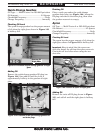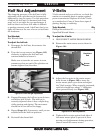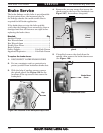
For Machines Mfg. Since 3/11 Turn-Nado
®
EVS Lathes
-75-
MAINTENANCE
Coolant System
Service
The coolant system consists of a fluid tank,
pump, and flexible nozzle. The pump pulls fluid
from the tank and sends it to the valve, which
controls the flow of coolant to the nozzle. As the
fluid leaves the work area, it drains back into
the tank through the chip drawer and catch tray
where the swarf is screened out.
Use Figures 112–113 to identify the locations of
the coolant system controls and components.
Although most swarf from machining operations
is screened out of the coolant before it returns
to the tank, small particles will accumulate in
the bottom of the tank in the form of sludge. To
prevent this sludge from being pulled into the
pump and damaging it, the pump’s suction tube
is positioned a couple inches from the bottom
of the tank and fitted with a fine screen. This
works well when the tank is regularly cleaned;
however, if too much sludge is allowed to
accumulate before the tank is cleaned, the pump
will inevitably begin sucking it up.
Hazards
As coolants ages and gets used, dangerous
microbes can proliferate and create a biological
hazard. The risk of exposure to this hazard can
be greatly reduced by replacing the old fluid
on a monthly basis, or as indicated by the fluid
manufacturer.
The important thing to keep in mind when
working with the coolant is to minimize exposure
to your skin, eyes, and lungs by wearing the
proper PPE (Personal Protective Equipment),
such as splash-resistant safety goggles, long-
sleeve waterproof gloves, protective clothing, and
a NIOSH approved respirator.
BIOLOGICAL & POISON
HAZARD!
Use the correct personal
protection equipment when
handling coolant. Follow
federal, state, and fluid
manufacturer requirements
for proper disposal.
Coolant
Pump Switch
Nozzle
& Valve
Lever
Figure 112. Coolant controls.
Chip Drawer
Catch
Tray
Figure 113. Additional coolant components.
Coolant Pump
& Tank


















